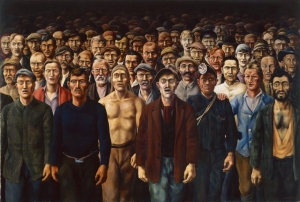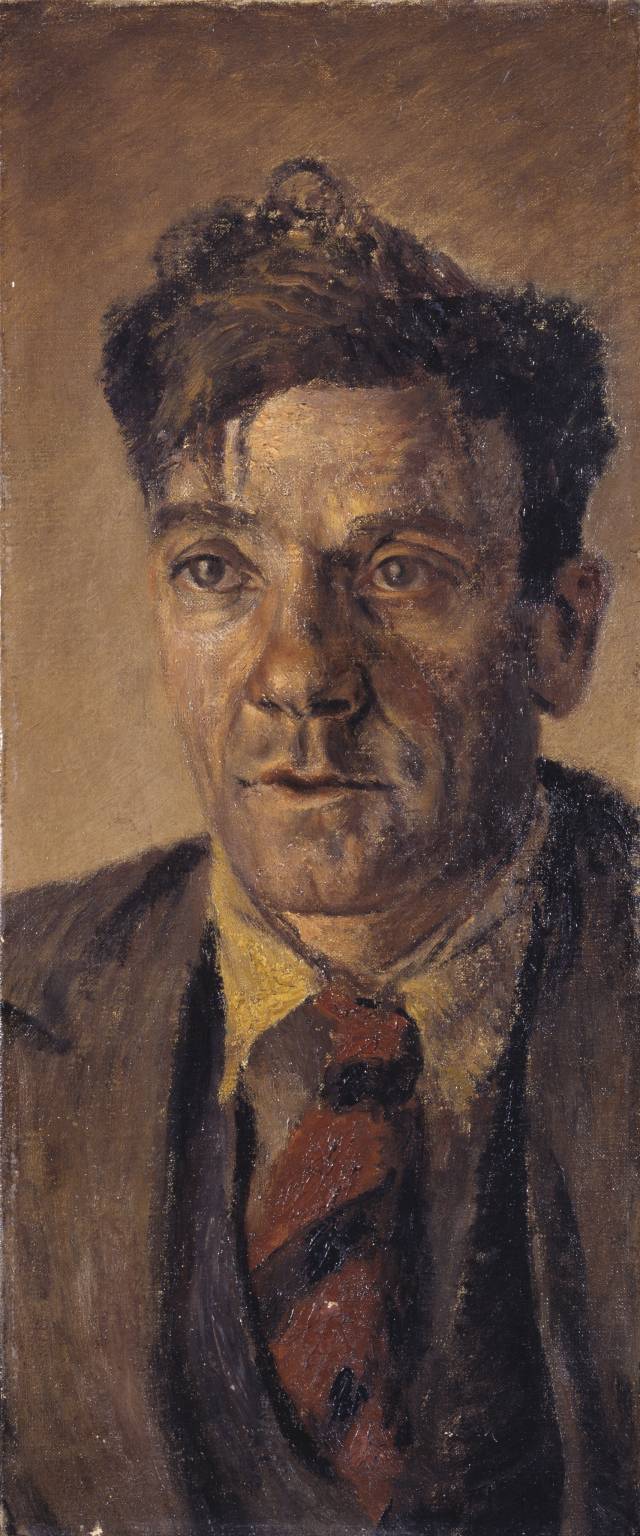
Victims of Capitalism: Art in the Wake of World War One
Christine Lindey reviews a new exhibition at Tate Britain, called Aftermath: Art in the Wake of World War One. It includes powerful, angry and sorrowful anti-war and anti-capitalist paintings, and some rarely shown, politically committed realism rooted in a socialist understanding of the capitalist greed which fuelled the carnage.
An earnest hush pervades Tate Britain’s exhibition as the public engages with an emotionally demanding topic whose relevance is all too sadly universal, but which for many, also has personal resonances. Seniors may have childhood memories of ancient, shell-shocked relatives whose crazed behaviour was indulged. Younger people may recall family stories or heirloom photos, war medals or regimental badges.

Paul Nash - Wire, 1918-19
The exhibition analyses the diverse new imagery and ways of making art provoked by British, French and German artists’ experiences of the war and its aftermath from 1916 to 1932. Many fought in the war. Like their fellow beings they struggled with the shock and incomprehension at the sheer scale of the destruction and devastation of human lives, lands, villages and towns brought by the world’s first mass mechanised warfare.

Christopher Richard Wynne Nevinson - Ypres After the First Bombardment, 1916
While many lifeless commissioned war memorials were produced a few artists created powerful expressions of helpless pain at the loss and mutilation of so many young lives. Charles Jagger’s moving bronze relief No Man’s Land, renders living, dead and dying soldiers in a traditional academic manner; but their miseries are unflinchingly observed and partly conveyed through modernist means. The soldiers are trapped in an expressive, angular composition within narrow, trench-like proportions and the bronze surfaces are strafed with frantic lines as if by whistling bullets or barbed wire.
Wilhelm Lehmbruck’s larger than life-size sculpture The Fallen Man also compromises between modernist simplification and realism. Its portrayal of a naked youth, lithe as a dancer but crawling head down unlikely to ever raise himself is profoundly emotive. Käthe Kollwitz’s woodcuts convey the despair endured by grieving widows and parents such as herself. The heartfelt sorrow with which she angrily slashed and grooved her woodblocks to delineate the figures expressive her emotional wounds.

Marcel Gromaire - War, 1925
Kollwitz’s anger shared by others stemmed from their socialist understanding of the capitalist greed for resources which fuelled the carnage. Their accusatory works called for political change. The French Communist Marcel Gromaire’s anti-militarist painting War, portrays soldiers as dehumanised tubular and globular forms in identical grey-blue uniforms which morph them into metaphors of their lethal weapons. Yet the foremost soldier’s naturalistically painted hands imply a touching vulnerability and the potential for resistance.

Otto Dix - Prostitute and Disabled War Veteran, Two Victims of Capitalism, 1923
Such indictments of capitalism were particularly numerous by German artists because they supported their country’s influential Communist and Socialist movements. John Heartfield’s magazine photomontages pulled no punches in resisting the nation’s militarist revival. Otto Dix’s savage distortions indicted the state’s shoddy treatment of amputees and of working class deprivation. George Grosz’s satires accused bourgeois complacency, corruption and exploitation through biting distortions and claustrophobic spacial recessions which sandwich their subjects.

George Grosz - “Daum” Marries her Pedantic Automaton “George” 1920
While umpteen European artists fretted over formalist dilemmas, a minority argued for an accessible, socially responsible art with which to combat capitalism. They exposed social injustice and asserted working class power. The narrow, cropped composition of Portrait of a Worker by the British Communist Clive Branson, focuses on the sitter’s intelligent, questioning gaze which refuses to shy away from the realities of life.

Clive Branson - Portrait of a Worker, c.1930
Gromaire’s Labourers demonstrates the social value of the building labourers’ work - particularly essential for France’s postwar reconstruction - while the labourers’ uncompromising confrontation of the viewer expresses their class’s political power. Seasoned socialists will be familiar with Otto Griebel’s famous painting The International, in which massed workers singing the Communist anthem march determinedly towards the viewer.

Otto Griebel - Die Internationale, 1929
That many of these works will be new to most of the British public stems from the cultural establishment’s long history of ignoring, marginalising or mocking such politically committed realism. The curators have done well to include them.
But the brief explanation of the complex ideological and stylistic postwar ‘Recall to Order’, which questioned the march of pre-war modernist styles, is ineffectual, and would be better served by a separate exhibition. The exhibition ends with a more relevant section about visions of new modern cities which would benefit from being larger, and which includes a stunning Léger.
The exhibitions’ intellectual base is weakened by a failure to adequately account for the differences between the three nations’ art, which is rooted in a glossing over of political contexts. The wall texts do not mention the Weimar Republic, yet its fostering of patronage of innovatory political art sprang from being the most politically and culturally progressive of these nations, which explains the dominance of progressive German art. The Bolshevik Revolution is also ignored, yet since this single, most seismic event of the postwar shaped the era’s socio-political and cultural debates throughout Europe.
But this otherwise intelligently curated exhibition dares to address a serious and important topic. The inclusion of copious contemporary documentation brings to life the period’s ambiences and preoccupations. As does the inclusion of ‘soldier art’- souvenirs fashioned by soldiers from spent shells in the trenches. Highly recommended.
Runs until September 23rd 2018. Box office: tate.org.uk. This review was also published in the Morning Star, 30 June - 1 July
